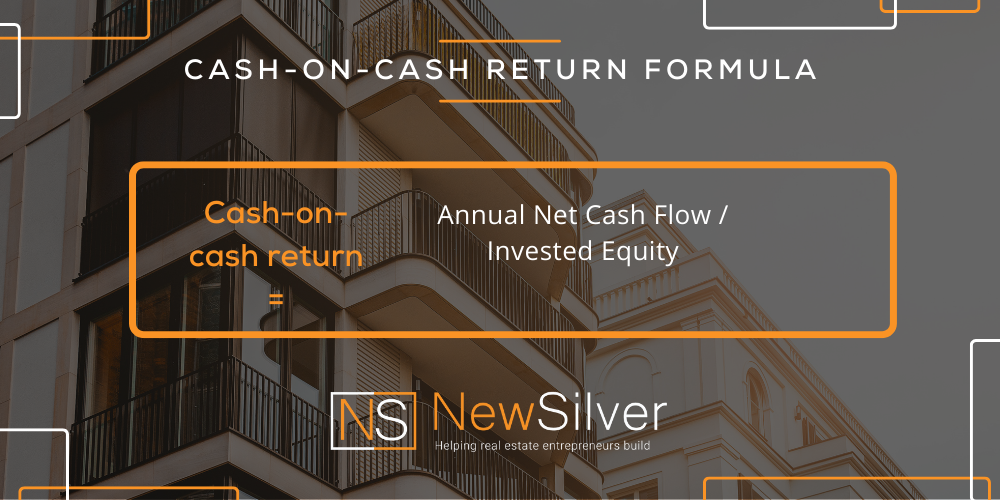Quick Summary
As a real estate investor, calculating the return on investment for a property that you own or are thinking about buying is one of the most useful tools to have. Check out our beginner’s guide on how to calculate cash-on-cash return and learn about using this formula to determine the success of an investment property.
Key Topics
One of the most important tools for real estate investors to have in their wheelhouse is being able to evaluate an investment property to see what the return on investment is. There are a few ways to do this, like using the capitalization rate or the rate of return. Investors often look through many properties to find one that is worth investing in, so having quick and reliable real estate investing metrics to use to determine an investment property’s potential to be successful, or indicate its current success, is a vital tool.
This is where the cash-on-cash return calculation comes in. This method uses the total cash that is earned on a property in comparison to the total cash invested in it, over a specific period. Read more to find out how to calculate cash-on-cash return for a property in our beginner’s guide.
What does the term cash-on-cash mean?
The term ‘cash-on-cash return’ refers to a real estate investing metric whereby the actual cash invested in a property is measured against the cash income that is earned by the property over a period of time. The idea behind this metric is to determine whether an investment property is providing an adequate return on investment.
This calculation is a practical way to directly compare money in and money out, on an investment property. Which makes deciding on a down payment and loan amount easier, because you can work out different options and check the direct impact on your returns by plugging the numbers into this formula.

How do you calculate cash-on-cash return?
The cash-on-cash calculation includes the equity that has been invested in the property, and the annual cash returns that the property is generating. This is essentially the cash flow for the property and is one of the easiest calculations to use for working out your return on investment (ROI).
The income generated by the property isn’t limited to rent only, and can include parking fees, storage rental and so on. This is all added together to work out the total amount of income that property is generating. The expenses are then subtracted from that and this number is divided into the overall cash invested into the property.
The difference between a standard ROI and the cash-on-cash formula is that the cash-on-cash return deals with the actual cash invested in the property, instead of providing the return on the overall investment. Which means that the cash-on-cash return is a more accurate metric for some investors to use to determine the success of an investment property.
Cash-on-cash return formula
Cash-On-Cash Return = Annual Net Cash Flow / Invested Equity

The cash-on-cash return formula is simple and one of the easiest ways to determine not only the success of a real estate investment, but also a property’s potential. The formula is calculated before tax. Among other functions, it is a useful calculation for real estate investors who are comparing investment properties, to see which would be the best to purchase.
This calculation gives investors a good idea of how each property will perform by looking at the returns that will be generated. Real estate investors can get a consistent view of the yields that they could earn over a longer period of time for different properties.
For the cash-on-cash return formula, you’ll need to work out your gross profit. Your gross profit is calculated by subtracting your expenses from the rent. These expenses include homeowners insurance, property taxes, any repairs or renovations that you’re doing and any maintenance fees.
It’s important to note however, that this formula doesn’t include debt on the property, so only the down payment and closing costs will be counted as cash that has been invested in the property. The mortgage will not count towards the initial investment. However, you can add the mortgage payments back into the calculation to get a better idea of the returns you will be getting.
Cash-on-cash return example
Let’s use some real-life examples to calculate the cash-on-cash return for a property so that you can see it in action.
Let’s say you bought a property for $200,000 and it was an all-cash deal. If you are renting out the property at $2,000 per month, this would generate $24,000 in 1 year. According to the cash-on-cash formula (using x 100 to figure out percentage) your return would be:
$24,000 / $200,000 = 12%
However, if this wasn’t an all-cash deal, then the calculation is slightly different. Let’s say that you took a mortgage of $150,000 instead and put $50,000 down payment on the same $200,000 house. This would mean that the cash-on-cash return calculation would be:
$24,000 / $50,000 = 48%
Now, if you had to factor in expenses on top of this, the calculation would be slightly more complicated. Let’s say the purchase price was $200,000 and $50,000 was a down payment from you, and the remaining $150,000 was taken out as a mortgage. Factoring in insurance costs, closing fees and maintenance costs that total $5,000 upfront would mean that these costs are subtracted from the first number. Your cash-on-cash return would then be:
$19,000 / $50,000 = 38%

What is a good cash-on-cash return?
Unfortunately, there is no hard and fast rule here. A good cash-on-cash return depends on the real estate market in a particular area, for example what’s considered a good cash-on-cash return in Los Angeles, may not be the same as Chicago. It’s also reliant on the strength of the economy at the time. The type of property you’re purchasing is another factor in the mix, along with how many repairs and renovations you are doing to the property.
Your preferences as an investor play a big part in this as well. Investors who are risk-averse, for example, may invest more equity into the property and therefore get a lower cash-on-cash return if there’s less leverage. So, for some investors a 10% cash-on-cash return would be sufficient if the property fulfils their other investing goals. Whereas some investors who aren’t planning on holding the property for too long would want more leverage and to invest less equity, so a higher cash-on-cash return of 20% would be more favorable.
Some investors say that a cash-on-cash return between 8% and 12% is a good range to be in. However, others say that between 5% and 7% is acceptable in certain real estate markets. It all comes down to the real estate market and each investors situation.
Is ROI the same as cash-on-cash?
Overall ROI and cash-on-cash returns are not the same and this is because ROI calculations are dealing with the returns on the entire investment, whereas cash-on-cash deals with the returns only on the actual cash that was invested in the property.
Standard ROI factors in the debt that is part of the real estate deal as it encompasses all the money that was invested, whereas the cash-on-cash return calculation excludes the debt and just focuses on the cash that was invested.
This makes the cash-on-cash formula a more accurate way to work out the exact performance of an investment property and make more informed investing decisions based on the actual equity that was put in.

How is year 1 cash-on-cash return calculated?
The cash-on-cash return calculation should ideally be done after a property has been in the investment holding period for 1 year. This is because the formula looks at the annual income and one year of cash flow.
So, after the first year of owning an investment property, you would work out the cash flow by calculating the net operating income (NOI). Which means, you’d subtract the expenses of the property from the income it has generated. Both the expenses and the income are calculated on an annual basis to determine the cash flow for the year.
Then you’ll take the actual cash invested into the property and divide it by the total amount of money that you have invested in the property, excluding any debt you may have, but including the closing costs and down payment.
Is higher cash-on-cash return better?
There’s no rule of thumb when it comes to what a good cash-on-cash return constitutes. So, a higher cash-on-cash return doesn’t necessarily mean that it’s better every time. It all depends on how much actual cash you have invested into the property or the size of the loan you’ve taken. The rate of return varies largely based on how much cash you’ve spent from your own pocket and what this means for your cash flow.
A higher return often means that you have more leverage because you’ve taken a larger amount as a loan than you’ve paid in from your pocket. So, while it may look good on paper, in reality the higher return might not be the best option. Under normal circumstances, the higher the return (even cash-on-cash) the better, but in this case, a lower return may not indicate a bad investment, so it’s vital to remember this.

Why cash-on-cash return is so useful for analyzing investment properties
The cash-on-cash return calculation a key real estate investing metric, however it should also be used in conjunction with other metrics to achieve the best overall picture of the property’s potential. Investors can use this metric for a few reasons:
- To determine whether a property will be a successful investment opportunity or not, with a quick and easy calculation that will provide a good estimate right away.
- To determine how much leverage an investor would need financially and what impact this would have on the deal’s returns.
- To compare investment properties or even compare different investments to real estate. The cash-on-cash return formula allows for easy comparisons between investments, even if they’re in different areas.
When using the cash-on-cash return formula, it’s best to evaluate the performance of a property which you’ve had for over 12 months. This will give the most accurate performance level, particularly for properties that were paid for using a loan or mortgage. As time goes, the loan is repaid more, and this complicates the cash-on-cash return so the end of the first year is the optimum time for the most accurate result.

